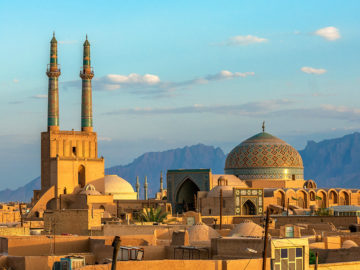
The historic square and complex known as Amir Chakhmaq is perhaps the highlight of Yazd located in one of the oldest neighborhoods of the city. Amir Jalal Al Din Chakhmaq, a general and ruler of the Timurid era, was assigned as the governor of Yazd. With the help of his wife Fatemeh Khatoun, he ordered the establishment of a series of constructs that included the mentioned square, a bathhouse, a caravanserai, a monastery, a water well, and a mosque.
The complex was known with the same name in the Safavid era too; when Shah Abbas ordered parts of it to be restored; namely, four souks built on the caravanserai. In the 18th century, the square in front of the mosque and the facade of the bazaar were turned into a gathering place. We know that the place could not have had a religious function back then, because the building of religious gathering centers began in the Safavid era and continued afterwards. It is commonly believed that the square turned into a religious center in the 18th century and a Tekyeh, or the religious center was built on the façade of the bazaar at that time. The inscription of the place proves that it is about 130 years old.
In the 18th century, the square in front of the mosque and the facade of the bazaar were turned into a gathering place.
In the eastern part of the square there is a bazaar that locals call Haji Qanbar which takes its name from Haji Qanbar Jahanshahi, a person that was assigned as the governor of Yazd by Jahanshah Kara Koyunlu. The Kara Koyunlu that literary means the owners of black ships were a Turkman tribe based in north-west of Iran. They used to be under the control of Timurid rulers but their indomitable nature didn’t accept being ruled by others and soon they declared independence, starting their own kingdom

Another significant thing regarding this square is its Nakhl. Nakhl is a wooden object made in different sizes and used as a symbol of a martyr’s coffin. It is also known to represent a cradle and refers to the innocence of the martyr and the life of that person in heaven. Since it has the shape of a tree, it came to be known as Nakhl or palm but in reality it is the representation of Sarv or cedar that is the symbol of resistance and is known to stand as the symbol of Iran. The Nakhl of Yazd is the biggest Nakhl of the country known as Heidaries Nakhl. On the annual anniversary of Imam Hossein’s martyrdom (the third Shia Imam) the Nakhl is moved around by more than 100 men. With an estimation of 450 years of age that dates back to the Safavid Era, the Nakhl is known to be one of the oldest such structures in Iran.
Another significant thing regarding this square is its Nakhl. Nakhl is a wooden object made in different sizes and used as a symbol of a martyr’s coffin.
The Amir Chakhmaq Tekieh was registered as a national heritage in 1951 followed by the Amir Chakhmaq mosque, registered 11 years later. Later the whole complex that included the square, the bazaar, the tekyeh and the mosque were registered as one.

